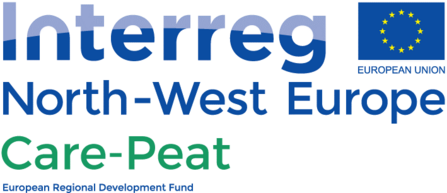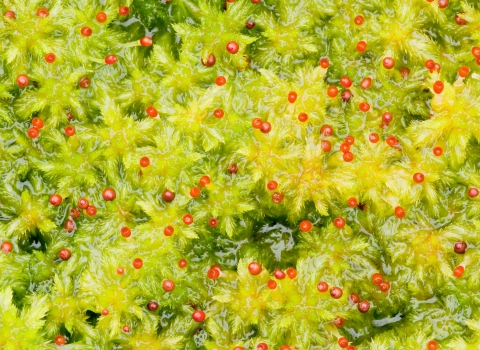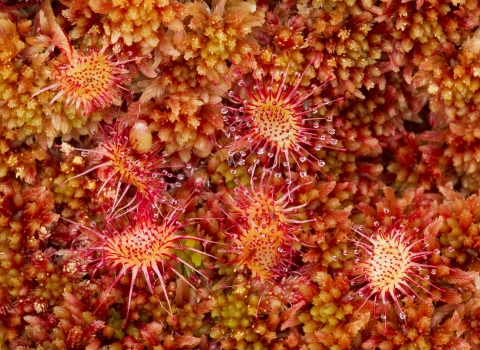
What is the Care-Peat partnership?
Care-Peat is an Interreg North-West Europe (NWE) project with 12 partners working together to reduce carbon emissions and restore the carbon storage capacity of different types of peatlands in North-West Europe. The main partnership consists of 7 knowledge institutes and 5 nature organisations from Belgium, France, Ireland, the Netherlands and the United Kingdom. Together with 5 sub-partners and 47 associated partners, we develop and test new techniques and socio-economic strategies for carbon reduction.
EU Funding: €4.22m | Total Budget: €7.03m | Timeline: 2019-2023
Why focus on peatlands?
Peatlands are not only habitats with a highly specialised flora and fauna, they also play an important role in global climate regulation. In fact, peatlands are our largest global carbon store. Not only do they contain more than 550 gigatonnes of carbon - they also store twice as much carbon as all the world’s forests.
Despite Northern hemisphere peatlands counting for just three to five per cent of total land area, they contain around 33 per cent of global soil carbon. Therefore, peatlands have a strong natural potential to save carbon and play an important role in nature-based solutions for climate change.
CO2 emissions from drained and burned peatlands equate to 10 per cent of all annual fossil fuel emissions
When peatlands are drained, the well-preserved carbon inside them is released as greenhouse gases into the atmosphere. That is why it is important to keep peatlands wet. Unfortunately, many peatlands are degraded and emit rather than store carbon: the global annual greenhouse gas emissions from drained organic soils are twice that from aviation, with CO2 emissions from drained and burned peatlands equating to 10 per cent of all annual fossil fuel emissions. We need to act now to prevent further degradation and encourage more recovery of our remaining peatlands.
The Care Peat project teams on Little Woolden Moss by Alan Wright
What does Care-Peat do?
The main goal of Care-Peat is to set up and demonstrate innovative technologies for new restoration and carbon measurement techniques and involve local and regional stakeholders.
Therefore the nature organisations (including Lancashire Wildlife Trust), together with local landowners, are restoring peatlands on the 7 different pilot sites ranging from one to 250 hectares and demonstrating the (potential) carbon savings of the restoration. For each pilot site different restoration techniques are used - from manual management to growing additional sphagnum moss. Throughout the project the organisations are supported by the knowledge institutes, working together to develop and test new equipment, methods and models to predict carbon flows (e.g. by the use of drones and satellites to guide restoration and provide input for carbon models). Care-Peat also works with innovative companies in the field of restoration and develops partnerships with local and regional stakeholders to increase the impact of pilots and maximise socio-economic benefits.
Important outputs of Care-Peat are the publication of a management and decision support tool, and a set of socio-economic models concerning the best options for peatland restoration in regard to carbon storage. This way the results of the project are transferred and replicated to users across North West Europe to determine the most appropriate management measures, even after Care-Peat has ended.
In 2021, as part of the Interreg NWE programme, the Care-Peat project was given the opportunity to strengthen its scope with a so called ‘capitalisation project’. The aim is to apply the project results to new areas and a new target group in North West Europe. The approval resulted in no less than 3 new partners and 6 new associated partners who joined our consortium.
In the capitalisation project we are developing a unified methodology for assessing GHG emissions from peatlands, that is widely applicable in North West Europe (different peatland types and regions), and thus increase the impact of the decision support tool. Also we include farmers and farmer organisations as a new main target group by engaging with them directly and incorporating best practices for carbon savings on farmland.
What are we doing at our Wildlife Trust?
On our Little Woolden Moss nature reserve in Salford, Greater Manchester, we are testing different combination planting techniques for their effect on greenhouse gas emissions and to see which combinations are the most effective for restoring damaged peatlands back to vital natural carbon stores.
We are also creating a pioneering carbon farm on an area of previously drained farmland next to our lowland raised bog, Winmarleigh Moss SSSI, near Garstang in Lancashire. We are piloting techniques to re-wet the land and growing a permanent cover crop of peat-forming sphagnum moss. As this grows and covers the site we are working with Manchester Metropolitan University to monitor greenhouse gas levels to see how quickly the site can be transformed from a carbon emitter to a carbon store.
The research data gleaned from the site will be used to support the adoption of this and other alternative land management techniques for our peatlands. We'll also assess the effect of re-wetting this buffer zone area on the functioning of Winmarleigh Moss. A study of the socio-economic aspects of this approach is also part of the Care-Peat project.
We will be sharing our work widely with stakeholders, and seeking their input, to help promote and disseminate beneficial techniques. BeadaMoss® are our sub-partner on the project and will be assisting with expert knowledge input into the design of the pilot and growing the sphagnum moss required.
The recent Care-Peat conference at Manchester Metropolitan University
How much carbon can be saved?
Care-Peat is ambitious. By the end of the project in 2023, we expect that about 8,137 tonnes of carbon emissions per year are prevented from losses and stored in the 7 pilot sites (in total approximately 645 hectares).
After 2023 we hope that nature conservation and other organisations all over the North-West Europe region will take forward further measures, resulting in the restoration of many more peatlands - and the more peatlands are restored, the more carbon is saved. In this way peatlands can become an important natural partner in climate policies across North West Europe.
Further resources
Workshop Resources: The climate emergency: the role of peatlands - from ambition to action (30 September 2020)
Please find below the workshop report and presentation materials delivered in the above workshop.
The workshop brought together policy makers and peatland professionals to discuss:
- Outline current and forthcoming UK and EU peat policies, strategies and practices
- Share the latest information about the Care-Peat project and our innovative work to support restoration of peatlands and reduction in associated emissions, including our pioneering carbon farm pilot
- Share and explore our ideas and understanding of what is needed to move rapidly to wide-scale adoption of alternative peatland management
- Set out collective steps to achieve this
- Create future opportunities for involvement


